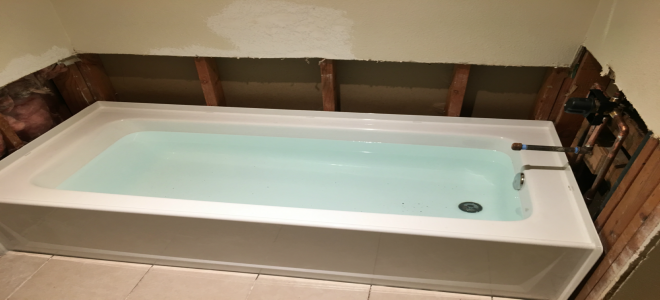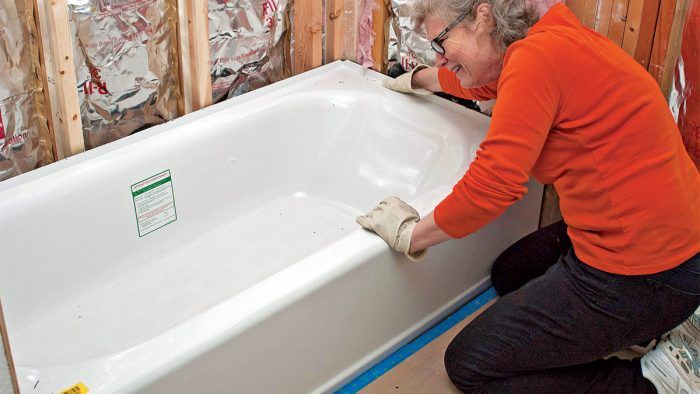Beginner's Plumbing: The Essentials for Bathtub Installation
Beginner's Plumbing: The Essentials for Bathtub Installation
Blog Article
We've stumbled on this post relating to How to Install a Bathtub below on the net and reckoned it made perfect sense to relate it with you over here.

Mounting a bathtub isn't precisely brain surgery, yet it does call for strong plumbing, carpentry, and occasionally, tiling abilities. Changing an old bath tub with a new one is also a reasonably challenging job. If the old tub is readily available, the job can move easily; if you need to open up a wall surface to eliminate the old tub and place the brand-new tub, the task is much harder. In either case, the task is within a residence handyman's abilities, although you will need an assistant to leave the old tub and embeded in the new one. Make sure you have actually certified yourself for the job and also fit attempting it. As opposed to employing a professional to take control of a halfway-completed job, it is better to take into consideration utilizing one before you start. Chances are you might need a specialist plumber to make tube connections.
This write-up will aid you install a new bath tub in your washroom if you have already acquired a new tub and also don't need to alter the setup of your previous supply of water pipelines.
Your tools and material list need to comprise the following:
Removing Old Taps
If you need to replace old taps with new ones as a part of your setup, then the first thing you should do is separate the water supply. After doing so, activate the faucets to drain pipes any kind of water remaining in the system. The procedure of eliminating the existing taps can be fairly problematic because of the restricted access that is often the situation.
Use a basin wrench (crowsfoot spanner) or a faucet tool to reverse the nut that connects the supply pipes to the taps. Have a fabric all set for the remaining water that will certainly come from the pipelines. When the supply pipes have been eliminated, make use of the same tool to loosen the nut that holds the taps onto the bath/basin. You will need to quit the solitary faucets from transforming throughout this procedure. As soon as the faucets have been eliminated, the holes in the bath/basin will certainly have to be cleansed of any kind of old sealing substance.
Prior to going on to fit the new faucets, contrast the pipeline connections on the old faucets to the brand-new faucets. If the old faucets are longer than the new faucets, after that a shank adapter is required for the brand-new faucets to fit.
Suitable New Touches
If the tails of the new taps are plastic, then you will certainly need a plastic connector to prevent damages to the string. One end of the port fits on the plastic tail of the faucet and also the other end gives a link to the current supply pipes.
If you require to fit a monobloc, then you will certainly require reducing couplers, which links the 10mm pipeline of the monobloc to the basic 15mm supply pipe.
Next off, position the faucet in the mounting hole in the bath/basin making sure that the washers are in location between the tap and the sink. Protect the faucet in place with the manufacturer given backnut. Once the faucet is safely in place, the supply pipelines can be connected to the tails of the faucets. The taps can either be linked by using corrugated copper piping or with typical faucet adapters. The previous type ought to be attached to the tap ends first, tightening only by hand. The supply pipes can later on be attached to the various other end. Tighten both ends with a spanner after both ends have been connected.
Installing the Tub
Making use of the two wooden boards under its feet, place the bathtub in the needed setting. The wooden boards are handy in equally spreading out the weight of the bath tub over the location of the boards as opposed to concentrating all the weight onto 4 little points.
The following objective is to make sure that the bath tub is leveled all round. This can be achieved by inspecting the level and changing the feet on the bath tub till the spirit level reviews degree.
To mount faucets, fit all-time low of the outermost flexible faucet adapter to the appropriate supply pipe by making a compression join; then do the exact same for the various other faucet.
Turn on the water and also inspect all joints as well as new pipework for leaks and tighten them if essential. Fill the bathtub as well as additionally examine the overflow outlet as well as the normal electrical outlet for leakages.
Finally, fix the bathroom paneling as explained in the producer's instruction manual. Tiling and also securing around the bathtub needs to wait up until the bathtub has actually been utilized at least once as this will certainly settle it right into its final placement.
Getting ready for the Installment
First of all, the supporting framework supplied with the bathroom ought to be fitted (if called for) according to the producer's guidelines. Next, fit the faucets or mixer to the bath tub. When suitable the faucet block, it is very important to see to it that if the tap includes a plastic washing machine, it is fitted between the bath as well as the faucets. On a plastic bathroom, it is additionally reasonable to fit a sustaining plate under the faucets device to stop pressure on the tub.
Fit the versatile tap ports to the bottom of the two taps using 2 nuts and also olives (often provided with the bathtub). Fit the plug-hole outlet by smearing mastic filler round the sink electrical outlet opening, and after that pass the outlet with the hole in the bathroom. Make use of the nut provided by the maker to fit the plug-hole. Take a look at the plug-hole outlet for an inlet on the side for the overflow pipeline.
Next, fit completion of the adaptable overflow pipeline to the overflow outlet. Afterwards, screw the pipe to the overflow face which must be fitted inside the bath. Make certain you use every one of the provided washers.
Connect the catch to the bottom of the waste electrical outlet on the bathtub by winding the string of the waste electrical outlet with silicone mastic or PTFE tape, and screw on the trap to the electrical outlet. Attach the bottom of the overflow tube in a similar manner.The bathroom need to now be ready to be fitted in its last placement.
Tiling Around the Bath tub
In the area where the bath meets the ceramic tile, it is essential to seal the joins with a silicone rubber caulking. This is essential as the installation can move enough to split an inflexible seal, creating the water to penetrate the wall between the bathroom and also the tiling, leading to problems with moisture as well as possible leakages to the ceiling listed below.
You can choose from a variety of coloured sealants to blend in your fixtures and fittings. They are sold in tubes and also cartridges, and can securing spaces up to a width of 3mm (1/8 inch). If you have a larger space to fill, you can fill it with spins of soaked paper or soft rope. Remember to constantly load the bathtub with water prior to securing, to allow for the movement experienced when the tub remains in usage. The sealant can fracture relatively very early if you do not take into consideration this activity before sealing.
Conversely, ceramic coving or quadrant tiles can be used to edge the bathroom or shower tray. Plastic strips of coving, which are easy to use and also reduce to dimension, are also conveniently available on the market. It is a good idea to fit the floor tiles making use of waterproof or water-proof adhesive and cement.
Bathtub Installation
How Important Is A Bathtub To Your Home?
High-quality baths, showers, and other bathroom updates are necessary when considering a smart investment in your home. It’s a room that you go to every day and one that is constantly being used by guests.The bathroom is one of the top trafficked rooms in a home and also one of the most valuable in terms of home resale.
Install Piping Before Tub
You will be using your existing drain and waste vent system, but pipes required include the hot and cold water supply lines and a pipe leading to a shower head. A mixing valve and shower head are also needed. Air chambers may be required.
Position the Tub
Lower the tub into place so that the continuous flange fits against the wall studs and rests on 1’x4' or 2’x4' supports. Anchor the tub to the enclosure with nails or screws inserted through the flanges into the studs.
NOTE: Remember, bathtubs and shower stalls may require support framing. A bathtub filled with water is extremely heavy, so check building codes and framing support before installing the tub.
Assemble Drain Connections
Assemble the bathtub drain connections by connecting the tub overflow with the tub drain above the trap, not beyond it. The trap will have a compression fitting that screws over the arm of the overflow assembly.
Place a Pipe For the Shower Head
First, locate a brass female threaded winged fitting and attach it to a framing support via a screw or a nail. Then run a pipe up the wall for the shower head. Sweat or solder the other side of the brass fitting to the top of the pipe.
Attaching Hot and Cold Water Lines
Attach your water lines for both hot and cold by sweating these directly into the hot and cold ports of the mixing valve. The mixing valve will be how water enters the tub’s system, not by the pipes themselves.
Install the Spout
Extend a piece of 1/2 inch pipe, or whichever length is specified in the manufacturer’s instructions, for the tub spout. Sweat on a male threaded fitting at the end of the pipe or use a brass nipple of the proper length and a 1/2 inch cap.
NOTE: At this point you should have your rough-in plumbing work inspected before proceeding further.
Check For Leaks
Restore the water pressure and check the drain connection and the supply pipes for any sign of leaking.
estore the Bathroom Wall
Replace the wall with moisture-resistant drywall as a base for your wall covering. Seal the joints between the wall and your new tub with silicone caulk as protection against water seepage.
https://www.berkeys.com/2016/12/02/bathtub-installation-dallas/

I am very focused on How to Install a Bathtub Yourself and I really hope you liked the new blog entry. Those who appreciated our post kindly don't forget to pass it around. Many thanks for your time spent reading it.
Connect for plumbing excellence now. Report this page